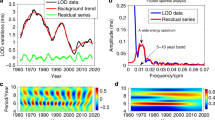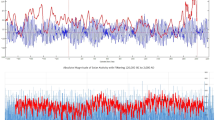Abstract
SINCE November 1955 a magnetic observatory has been in operation at University College, Ibadan (lat. 7° 26′ N., long. 3° 54′ E.), 2° 34′ south of the magnetic equator. Between November 25, 1956, and January 22, 1957, photographic recordings of the variation of the horizontal component H of the Earth's magnetic field were made for a period of a week at each of nine field stations between lat. 6° 36′ N. and 13° N.; that is, between about 3° north and 3° south of the magnetic equator. Records were taken with a simple temperature-compensated variometer, and were supplemented by frequent QHM readings. The whole period was relatively quiet magnetically, and the records at all stations included a number of quiet days.
This is a preview of subscription content, access via your institution
Access options
Subscribe to this journal
Receive 51 print issues and online access
$199.00 per year
only $3.90 per issue
Buy this article
- Purchase on Springer Link
- Instant access to full article PDF
Prices may be subject to local taxes which are calculated during checkout
Similar content being viewed by others
References
Chapman, S., and Bartels, J., “Geomagnetism”, 242 (1940).
Author information
Authors and Affiliations
Rights and permissions
About this article
Cite this article
ALEXANDER, N., ONWUMECHILLI, C. Variation of the Horizontal Force near the Magnetic Equator. Nature 180, 191–192 (1957). https://doi.org/10.1038/180191a0
Issue Date:
DOI: https://doi.org/10.1038/180191a0
This article is cited by
Comments
By submitting a comment you agree to abide by our Terms and Community Guidelines. If you find something abusive or that does not comply with our terms or guidelines please flag it as inappropriate.



